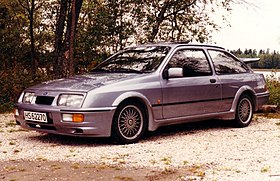Ford Sierra RS500
| Ford Sierra RS Cosworth | |
|---|---|
 |
|
| Overview | |
| Manufacturer | Ford Europe |
| Production | 1986–1992 |
| Body and chassis | |
| Body style |
3-door hatchback (1986-1987) |
| Layout |
front engine, |
| Related | Ford Escort RS Cosworth |
| Powertrain | |
| Engine |
Cosworth YBD, 204 hp (1986) |
| Transmission |
5-speed |
| Dimensions | |
| Length |
446 cm (1986-1987) |
| Width |
173 cm (1986-1987) |
| Height | 138 cm (1986-1992) |
| Curb weight |
1217 kg (1986-1987) |
3-door hatchback (1986-1987)
front engine,
rear wheel drive (1986-1989)
Cosworth YBD, 204 hp (1986)
Cosworth YBD, 224 hp (1987)
Cosworth YBD, 204 hp (1988-1989)
5-speed
Borg Warner T5 (1986-1989)
446 cm (1986-1987)
173 cm (1986-1987)
1217 kg (1986-1987)
1206 kg (1988-1989)
The Ford Sierra RS Cosworth is a high-performance version of the Ford Sierra that was built by Ford Europe from 1986 to 1992. It was the result of a Ford Motorsport project with the purpose of producing an outright winner for Group A racing in Europe.
The project was defined by Stuart Turner in the spring of 1983. He had recently been appointed head of Ford Motorsport in Europe, and he realised right away that Ford was no longer competitive in this area.
Turner got in touch with Walter Hayes, at the time the vice-president of public relations at Ford, to get support for the project. Hayes had earlier been the driving force behind the development of the Ford GT40 that won Le Mans in 1966, and the Cosworth DFV engine that brought Ford 154 victories and 12 world championships in Formula One during the 1960s and 1970s. Hayes found the project very appealing and promised his full support.
Turner then invited Ken Kohrs, vice-president of development, to visit Ford’s longtime partner, the automotive company Cosworth, where they were presented a project developed on Cosworth’s own initiative, the YAA engine. This was a twin cam, 16-valve engine based on Ford’s own T88 engine block, better known as the Pinto. This prototype proved an almost ideal basis for the engine Turner needed to power his Group A winner.
Therefore, an official request for a turbocharged version (designated Cosworth YBB) capable of 180 HP on the street and 300 HP in race trim, was placed. Cosworth answered positively, but they put up two conditions: the engine would produce not less than 150 kW (204 HP) in the street version, and Ford had to accept no fewer than 15,000 engines. Turner’s project would only need about 5,000 engines, but Ford nevertheless accepted the conditions. The extra 10,000 engines would later become one of the reasons Ford also chose to develop a four door, second generation Sierra RS Cosworth.
...
Wikipedia
